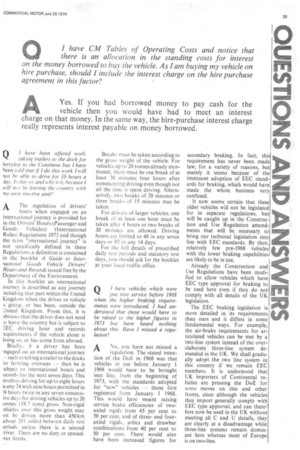Q I have vehicles which were 'NC put into service before
Page 45

If you've noticed an error in this article please click here to report it so we can fix it.
1968 when the higher braking requirements were introduced. I had understood that these would have to be raised to the higher figures in 1973 but have heard nothing about this. Have I missed a regulation?
ANo, you have not missed a regulation. The stated intention of the DoE in 1968 was that vehicles in use before January 1 1968 would have to be brought into line, from the beginning of 1973, with the standards adopted for "new" vehicles — those first registered from January 1 1968. This would have meant raising service brake efficiencies of twoaxled rigids from 45 per cent to 50 per cent, and of threeand fouraxled rigids, artics and drawbar combinations from 40 per cent to 50 per cent. There would also have been increased figures for secondary braking. In fact, this requirement has never been made law, for a variety of reasons, but mainly it seems because of the imminent adoption of EEC standards for braking, which would have made the whole business very confused.
It now seems certain that these older vehicles will not be legislated for in separate regulations, but will be caught up in the Construction and Use Regulation amendments that will be necessary to bring our technical legislation into line with EEC standards. By then, relatively few pre-1968 vehicles with the lower braking capabilities are likely to be in use.
Already the Construction and Use Regulations have been modified to allow vehicles which have EEC type approval for braking to be used here even if they do not comply with all details of the UK legislation.
The EEC braking legislation is more detailed in its requirements than ours and it differs in some fundamental ways. For example, the air-brake requirements for articulated vehicles can be met by a two-line system instead of the overelaborate three-line system demanded in the UK. We shall gradually adopt the two line system in this country if we remain EEC members. It is understood that UK importers of Continental vehicles are pressing the DoE for some moves on this and other fronts, since although the vehicles they import generally comply with EEC type approval, and can therefore now be used in the UK without meeting all C and U details, they are clearly at a disadvantage while three-line systems remain dominant here whereas most of Europe is on two-line.
































































































